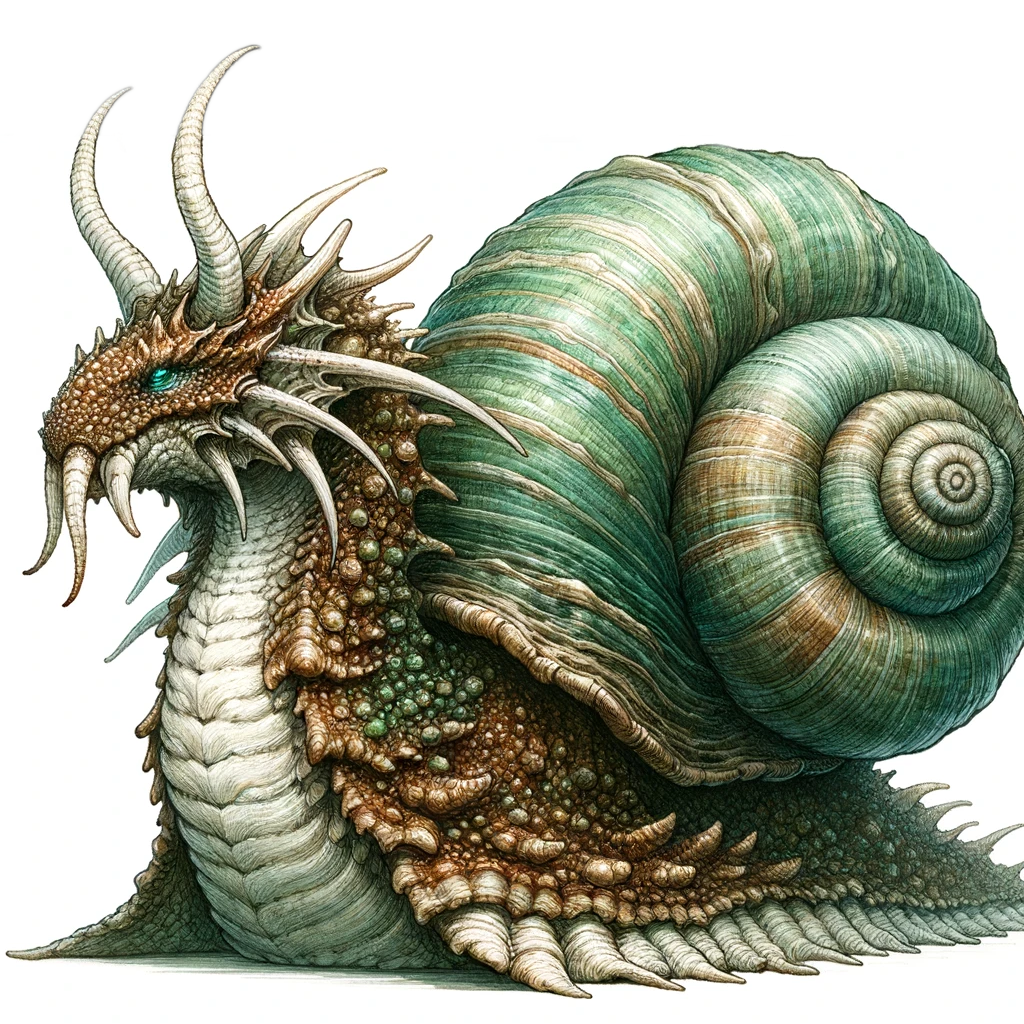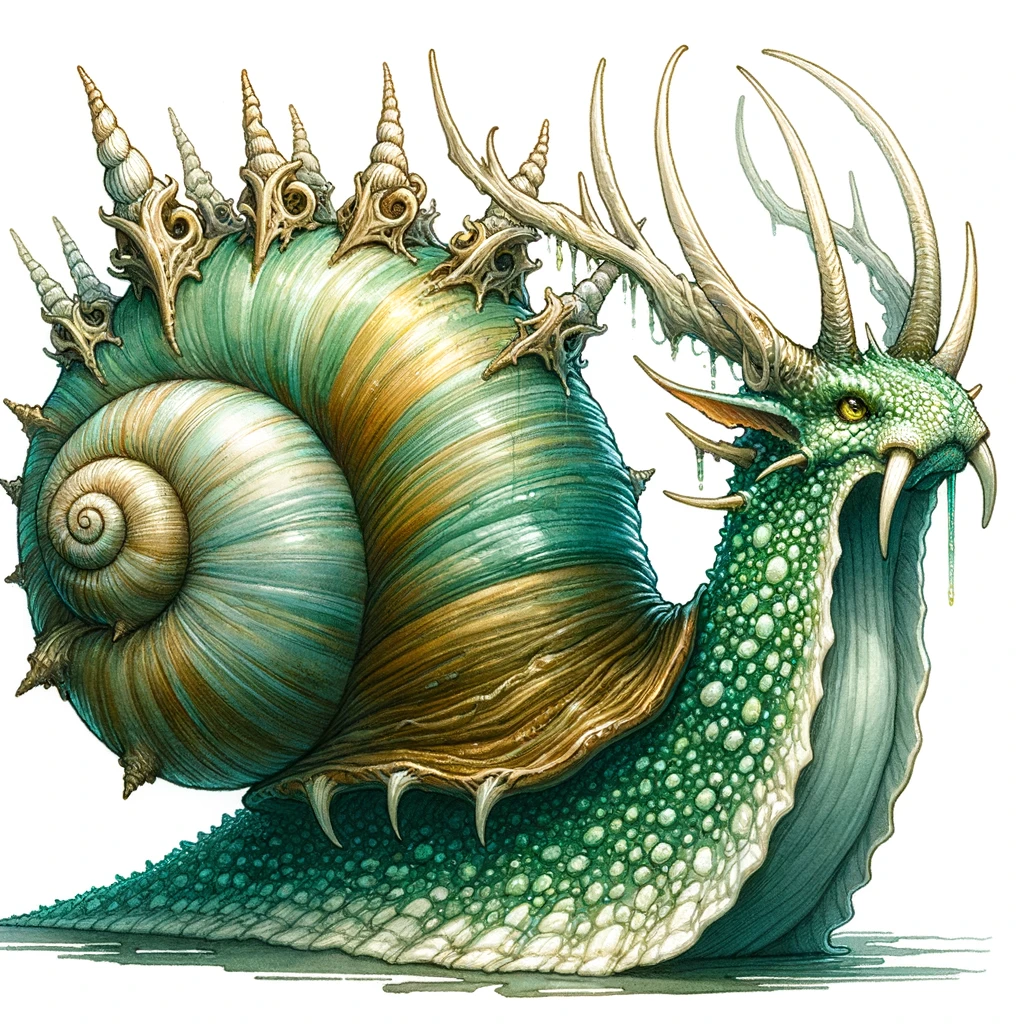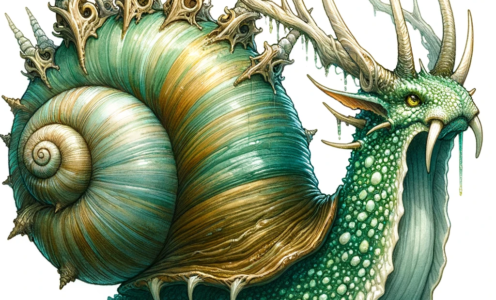Limaxian Dragon
| CLIMATE/TERRAIN: | Elysium; Eronian forests, Amorian meadows, Belierin marshes |
| FREQUENCY: | Very Rare |
| ORGANISATION: | Solitary |
| ACTIVITY CYCLE: | Day |
| DIET: | Herbivore, fungivore |
| INTELLIGENCE: | Very (11-12) |
| TREASURE: | Special |
| ALIGNMENT: | Neutral Good |
| NO. APPEARING: | 1 (2-5) |
| ARMOUR CLASS: | -1 / -4 (base) |
| MOVEMENT: | 6 |
| HIT DICE: | 10 (base) |
| THAC0: | 11 (at 10 hit dice) |
| NO. OF ATTACKS: | 3 + special |
| DAMAGE/ATTACK: | 1d6 / 1d6 / 1d12 |
| SPECIAL ATTACKS: | Spore cloud, acid spit |
| SPECIAL DEFENCES: | Slime trail, shell |
| MAGIC RESISTANCE: | Variable |
| SIZE: | L (10′ base) |
| MORALE: | Steady (11) |
| XP VALUE: | Variable |

Dragons are only a small part of the Multiversal flora and fauna, and are curiously sparse on the Outer Planes. In the verdant woodlands and fields of Elysium, however, the Limaxian dragon can be found. Anatomically unlike most dragons, the Limaxian dragon has neither limbs, wings nor scales. It most closely resembles a huge garden snail, with a pearlescent shell that grows with age. Its head is draconian in appearance, with slitted reptilian eyes and a forked tongue. Its hide is a glittering emerald in colour, and its many ivory horns spiral and point this way and that. Despite its scary appearance, the Limaxian dragon does not radiate any dragon fear, nor does it care to.
COMBAT: The Limaxian dragon avoids combat whenever possible, as it is by nature a pacifistic creature. Its shell has a base AC of -4, which improves as the dragon gets older. While the shell can be damaged by any weapon, its hide can only be damaged by edged or pierced weapons, due to its elasticity. The shell contains most of the dragon’s vital organs, and fortunately for the dragon it gains the resiliency of stone over time. If the dragon is damaged for more than 25% of its hit points, the dragon retracts its head, tail, and other softer (base armour class -1) body parts completely into its shell, leaving only its horns exposed. When the dragon loses half of its hit points it will extract itself from its shell and fight fiercely.
With slashing horns the dragon can do 1d6/1d6 points of damage each round in addition to 2d6 points of bite damage. Anyone near its vestigial tail can be slashed for 1d6 points of damage as well.
Three times a day, once every three rounds the dragon can spit a blob of acidic goo at anything within 90 feet. The diameter of the goo splash increases as the dragon gets older, 5′ per age category. Thus, as an Adult (category 5) the dragon can spit an acidic blob that affects everything in a roughly 25′ diameter circle. All creatures caught in this area can save vs. breath weapon for half damage. The acidic goo corrodes and dissolves almost anything, and must be washed off for the substance to stop dissolving things.
If not washed off a living creature or object, the goo continues to do 1d6 points of damage per age category per round for as many rounds as the age category of the dragon. For example, our Adult Limaxian dragon’s acidic blob will continue to do 5d6 points of damage each round for 5 rounds after it is initially spat. The Limaxian dragon is immune to the effects of its own acidic goo. Creatures and objects disintegrated by the goo make excellent fertiliser in Elysium after the acid loses its potency.
Mushrooms and other fungi are the main bulk of a Limaxian dragon’s diet. When it eats fungus it can somehow extract the spores from its meal and store them in a special chamber in its digestive tract. This stored spore supply can be breathed up to three times a day, once every three rounds, in a cloud 50′ long, 40′ wide, and 30 feet high at opponents. Each victim within the cloud must save versus breath weapon or suffer 1d6 of the following effects, rolled randomly:
- Forget – similar to the 2nd level wizard spell
- Confusion – as the 4th level wizard spell
- Otto’s Irresistible Dance – as the 8th level wizard spell
- Tasha’s Uncontrollable Hideous Laughter – as the 2nd level wizard Spell
- Ray of Enfeeblement – as the 2nd level wizard spell
Emotion: Happiness – as the 4th level wizard spell
Note that each effect(s) affect the victim separately, so the DM must roll for each victim who missed his/her save versus breath weapon. Also, the effects are non-magical in nature, so magic resistance does not apply, although immunities to poison may. Some effects may contradict and counteract each other, at the DMs discretion.

At birth, the Limaxian dragon is immune to acid and any fungus toxins. As they age, they gain the following additional powers:
- Very Young: Sanctuary once a day.
- Juvenile: Obscurement once a day.
- Adult: Remove Fear once a day.
- Old: Entangle once per day.
- Venerable: Plant & Fungus Growth once a day.
- Great Wyrm: Pass Without Trace three times a day.
Additional Priest spells gained with age are usually from the Animal, Plant, Protection, Sun, and Charm spheres (see table).
Finally, the Limaxian dragon leaves a slime trail behind it wherever it goes. Its lair may be coated with this slime, as will the area immediately behind it in a 10′ wide swath. Anyone treading on the slimy area is subject to the effects of a Grease spell, but must save versus paralysation, rather than magic, to avoid its effects.
HABITAT/SOCIETY: Limaxian dragons are found in peaceful sylvan areas of Elysium. They prefer secluded glens, valleys, forests, meadows or fields and will lair in a cave nearby. Most creatures are initially intimidated by the dragon’s fearsome appearance, but since it does not radiate any dragonfear aura, it can make friends easily. It prefers the company of woodland creatures, faerie folk, and peaceful races.
Limaxian dragon couplings are infrequent, as they tend to live for extremely long periods of time. They will pair up until their 2 to 6 eggs hatch and the young reach 50 years (Juvenile) of age.
ECOLOGY: The area around any Limaxian dragon lair is always verdant and extremely lush with vegetation and fungi. This is because the dragon’s slime trail not only helps decay and fertilise the area it coats, but the slime also contains spores for the growth of new fungi. Diverse species of fungus can be found near a Limaxian Dragon lair, and the dragon may know medicinal uses of almost every fungus species in the area. A cave inhabited by a Limaxian Dragon will almost always be filled with fungi, many of an offensive nature (violet fungi, shriekers, etc.).
Few creatures prey on the Limaxian dragon, as they are difficult to hunt and kill, and their flesh tastes like dirt. The dragon is a strict herbivore, and cannot digest meat, gems, or other things that most dragons crave. The dragon’s shell becomes brittle soon after the dragons’ demise, and is possibly useful only for magical spell components of spells in the Enchantment / Charm spheres of magic.
CURRENT CHANT: Some fungi found only near Limaxian dragon lairs can cure extremely rare magical and natural diseases. Others have strange magical effects for those that eat them, including plane shift, divination, and other curious results.
| Age | Length | AC | Breath Weapon | Spells (Priest) | MR | Treasure Type | XP Value |
| 1 | 3-6 | 2 / -1 | 1d6+1 | Nil | Nil | Nil | 2,000 |
| 2 | 6-11 | 1 / -2 | 2d6+2 | Nil | Nil | Nil | 4,000 |
| 3 | 11-17 | 0 / -3 | 3d6+3 | Nil | Nil | Nil | 5,000 |
| 4 | 17-21 | -1 / -4 | 4d6+4 | 1 | 10% | Nil | 7,000 |
| 5 | 21-24 | -2 / -5 | 5d6+5 | 2 1 | 15% | 1/2 F | 8,000 |
| 6 | 24-27 | -3 / -6 | 6d6+6 | 2 2 | 20% | F | 10,000 |
| 7 | 27-30 | -4 / -7 | 7d6+7 | 3 2 1 | 25% | F | 11,000 |
| 8 | 30-33 | -5 / -8 | 8d6+8 | 3 3 1 | 30% | F | 13,000 |
| 9 | 33-36 | -6 / -9 | 9d6+9 | 4 3 2 1 | 40% | F x 2 | 14,000 |
| 10 | 36-39 | -7 / -10 | 10d6+10 | 4 3 2 2 1 | 50% | F x 2 | 16,000 |
| 11 | 39-41 | -8 / -11 | 11d6+11 | 5 4 3 3 2 1 | 60% | F x 2 | 17,000 |
| 12 | 41-44 | -9 / -12 | 12d6+12 | 5 4 3 3 2 2 1 | 70% | F x 3 | 19,000 |
Source: Jim Barrett, art inspired by Zak Arntson



>Dragons are only a small part of the Multiversal flora and fauna, and are curiously sparse on the Outer Planes.
WotC: uh-huh. Noted. Anyways, here’s a dragon for every plane ever
But in all honesty, I absolutely love this design (much more than that of an official Elysium dragon), and snails are rare to come by in fantasy, especially in good connotations. It also resembles me Rust Dragons.
It’s adorable isn’t it? I was really pleased with how the art turned out for this one. I also did some research to find out why Jim called it ‘limaxian’ – the best answer I found is that it;s named after a genus of sea slug which is covered with ornate horns all over its body <3
OH MY GOODNESS. This is quite possibly the cutest creature I’ve ever seen, the ideal specimen!